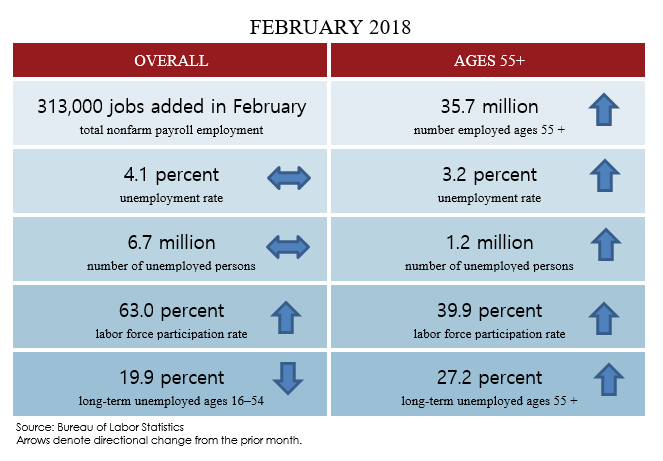AARP Hearing Center
Economy Adds 313,000 Jobs in February
By Jennifer Schramm, March 9, 2018 04:15 PM

Employment Overview
February 2018 was the strongest month for jobs growth since July 2016, with 313,000 jobs added to the economy. Despite this growth, the Bureau of Labor Statistics (BLS) February Employment Situation Summary showed that the unemployment rate for people ages 55 and older increased from 3 percent in January to 3.2 percent in February. The number of unemployed persons ages 55+ also increased, to 1.2 million, up from 1.1 million in January. The percentage of 55+ jobseekers considered long-term unemployed (those job searching for 27 weeks or more) grew from 24.8 percent in January to 27.2 percent in February. For the fifth consecutive month, the overall unemployment rate (4.1 percent) remained unchanged. The labor force participation rate increased to 63 percent, up from 62.7 percent in January.
Spotlight on Labor Force Participation Trends
The labor force participation rate is defined as the percentage of the population that either is currently working or is actively seeking employment. Since the start of the Great Recession in 2007, older age groups have seen a rise in their labor force participation rates. Over the past 30 years, labor force participation rates (LFPR) among those age groups traditionally considered at or beyond retirement age have increased sharply.
According to the BLS, between 1987 and 2017 the LFPR rose from 19.5 percent to 32.3 percent for workers ages 65—69, from 10.2 percent to 19.7 percent for workers ages 70—74 and from 4.2 percent to 8.3 percent for workers ages 75+. This contrasts with younger workers, whose labor force participation rates declined. The annual average LFPR declined from 68.4 percent for the 16—24 age group to 55.5 percent and from 82.5 percent to 81.7 percent for those ages 25—54.
The 1980s was the decade with the lowest levels of labor force participation among the 65+ age group, due in part to greater access to employer-based retirement benefits, such as pensions, and economic conditions that enabled people to save for retirement. Since then, access to pensions has declined and the steady rise in wages, leading many older workers to remain on the job longer for financial reasons.
The newest BLS forecasts predict that the share of workers ages 55 and older will grow to 24.8 percent in 2026, up from 16.8 percent in 2006. Along with finances, other factors such as longer lifespans, improved health, and gains in education lend support to projections that the share of older workers will continue to grow in the years ahead.
Find more details on the latest employment data in the February Employment Data Digest, PPI’s monthly review of job trends for those ages 55 and over.

Jen Schramm is a senior strategic policy advisor at the AARP Public Policy Institute. As part of the Financial Security Team, she identifies policy challenges and opportunities related to workers age 50 and above. Through research and analyses of emerging employment trends, she develops policy options to inform AARP’s strategy on work and jobs, including helping older workers find and retain jobs.































































